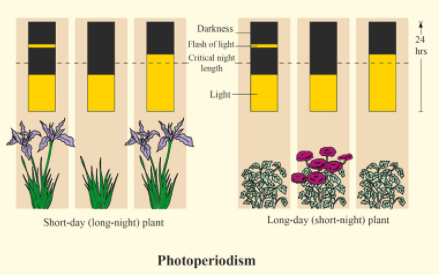
What is a critical photoperiod? On the basis of this, plants are categorized in how many types?
Answer
567.6k+ views
Hint: The photoperiod is defined as the duration of light which each day is received by the plants and the development of the plant depends on the light hours received by it.
Complete answer:
The fixed day length light period below or above of which the plant never blooms is known as critical photoperiod. Different species of plants have different critical photoperiods. On the basis of this, plants are categorized into three types. The three types are as follows:-
-Short Day Plants (SDP):
Short-day plants generally require a light period of but 12 hours i.e. 8-10 hour and a continuous dark period of about 14-16 hour for subsequent flowering. Most of the winter flowering plants belong to the present category e.g. Xanthium, Dahlia, sugarcane, rice, potato.
-Long Day Plants (LDP):
Long day plants require a light period of 14-16 hour for subsequent flowering. The quality of those plants is that a long night period entirely prevents flowering. But sometimes long nights are interrupted by light, even briefly, cause the inhibitive effect of the night to be lost, and therefore the plant's flower. These plants are sometimes also called as short night plants. E.g. Spinach etc.
- Day Neutral Plants:
These plants flower altogether during photoperiods and may blossom throughout the year. Examples are tomato, cucumber, etc. These plants produced more fruits as they require normal conditions.

Note: It is very interesting to note that the photoperiod also affects the milk yielding of the animals. If cows received sunlight for a long time it was recorded that milk yield increased by 8%–10%. In 1920, photoperiod was discovered by Garner and Allard.
Complete answer:
The fixed day length light period below or above of which the plant never blooms is known as critical photoperiod. Different species of plants have different critical photoperiods. On the basis of this, plants are categorized into three types. The three types are as follows:-
-Short Day Plants (SDP):
Short-day plants generally require a light period of but 12 hours i.e. 8-10 hour and a continuous dark period of about 14-16 hour for subsequent flowering. Most of the winter flowering plants belong to the present category e.g. Xanthium, Dahlia, sugarcane, rice, potato.
-Long Day Plants (LDP):
Long day plants require a light period of 14-16 hour for subsequent flowering. The quality of those plants is that a long night period entirely prevents flowering. But sometimes long nights are interrupted by light, even briefly, cause the inhibitive effect of the night to be lost, and therefore the plant's flower. These plants are sometimes also called as short night plants. E.g. Spinach etc.
- Day Neutral Plants:
These plants flower altogether during photoperiods and may blossom throughout the year. Examples are tomato, cucumber, etc. These plants produced more fruits as they require normal conditions.

Note: It is very interesting to note that the photoperiod also affects the milk yielding of the animals. If cows received sunlight for a long time it was recorded that milk yield increased by 8%–10%. In 1920, photoperiod was discovered by Garner and Allard.
Recently Updated Pages
Why are manures considered better than fertilizers class 11 biology CBSE

Find the coordinates of the midpoint of the line segment class 11 maths CBSE

Distinguish between static friction limiting friction class 11 physics CBSE

The Chairman of the constituent Assembly was A Jawaharlal class 11 social science CBSE

The first National Commission on Labour NCL submitted class 11 social science CBSE

Number of all subshell of n + l 7 is A 4 B 5 C 6 D class 11 chemistry CBSE

Trending doubts
Differentiate between an exothermic and an endothermic class 11 chemistry CBSE

10 examples of friction in our daily life

One Metric ton is equal to kg A 10000 B 1000 C 100 class 11 physics CBSE

Difference Between Prokaryotic Cells and Eukaryotic Cells

State the laws of reflection of light

Explain zero factorial class 11 maths CBSE




